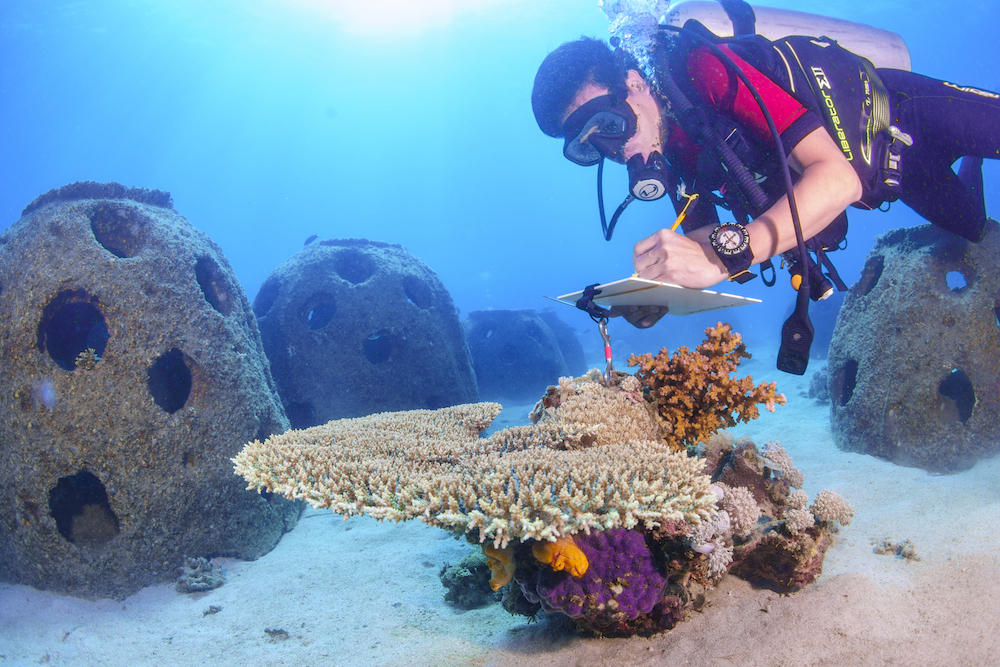Our Stories
Restoring a Devastated Marine Ecosystem: The Success of B2Gold Masbate’s Artificial Coral Reef Project

June 28, 2023
Back in 2013, B2Gold’s environmental team at the Masbate Mine in the Philippines, saw an opportunity to help conserve a fragile marine environment – by preventing further damage, and also restoring it to health and resilience. The Colorada Point marine area, off the coast of Masbate Island where our Masbate Mine is located, was being devastated by local dynamite fishing, causing severe damage to the coral reef ecosystem in particular.
Our team committed its support, and in 2017, after several years of collaboration with stakeholders, a 129-hectare Marine Protected Area (MPA) was established at Colorada Point, with the aim of rehabilitating and protecting the marine ecosystem using artificial reef technologies.
Giving the ocean a ‘leg-up’: nurturing biodiversity with artificial reef technology
Our Masbate team partnered with the Reef Ball Foundation, a non-profit environmental conservation organization based in the United States, to adopt artificial reef modules, known as Reef Balls. Divers deploy the balls in the Colorada MPA, where coral species use them to propagate, helping accelerate recovery of the reef. Construction and deployment of Reef Balls started in 2017, and restoration is occurring in conjunction with conservation of the marine environment.
The propagation and deployment team includes employees from the local Masbate Environmental department, women from local communities and volunteer divers from two local diving clubs. Wardens (recruited from the local fisherfolk) now actively patrol the MPA to keep dynamite fishing and other harmful activities at bay.
By the end of 2022, the team had deployed 2,993 reef balls with 51,374 propagules planted. The difference is obvious – with the sea showing what it can do if it has a leg-up, says Lovelle Cariaga, Acting Environmental Manager.
“Three of eight species of giant clam in the Philippines – Tridacna squamosa, Tridacna maxima and Tridacna gigas – have recently been spotted in the area,” says Cariaga. “We consider Tridacna maxima and gigas to be ‘natural recruits’; the presence of these recruits signals that the reef is coming back to life.”
Monitoring has further shown that planted coral propagules continue to thrive, with survival rates of 26 genera to be over 75 per cent, adding to the genetic diversity of the protected area.
B2Gold’s long-term commitment to conservation and responsible mining
The resurrection of the reef is only part of the story. Establishing protected areas and involving the community in conservation and decision-making has other, far-reaching benefits as well.
“Our efforts create awareness of resource management and protection,” says Geronimo Badulis, Resident Manager of the Masbate Gold Project. “It encourages stakeholders to actively participate and share a common vision of sustainable coastal resource use.”
This awareness and shared vision are evident when community members talk about the project, as well. Like Darwin Regala, local fisherman and MPA Warden: “I earn now the same as when I was dynamite fishing in this area, but now I have hope for my children that they will have a coral reef here when they are big enough to fish.”
As B2Gold continues to support the MPA, and transfers management responsibility to the Local Government Unit, the legacy of the Masbate Environmental team’s work will continue to live on for generations to come.
Read more about our Masbate environmental and community projects in our latest B2Gold Responsible Mining Report.


